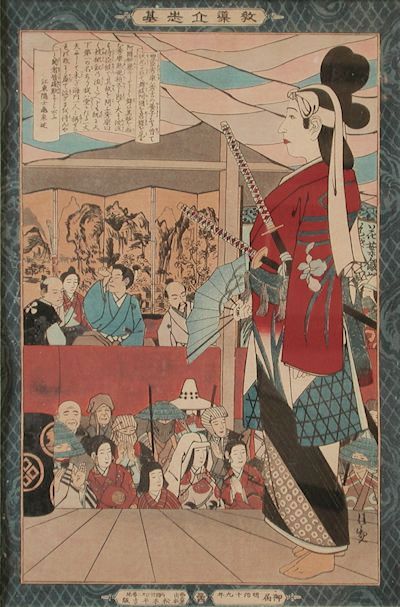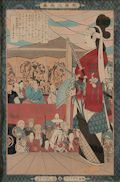| Title: |
Young Nobleman, Toyotomi Hideyasu, is Moved to Tears by the Performance of the Female Dancer, Okuni at Fushimi Castle |
| Artist: |
Kiyochika, Kobayashi (Japan, 1847 - 1915) |
| Date: |
1886 |
| Medium: |
Original Japanese Woodcut |
| Publisher: |
Matsuki Heikichi |
| Series: |
Instructive Models of Lofty Ambition |
| |
Kobayashi Kiyochika: Along with Yoshitoshi, Kiyochika ranks as the greatest woodcut
master of late nineteenth century Japanese art. He has been called both
the last great artist of traditional ukiyo-e art and as the first great
exponent of the modern Japanese woodcut. In either case his influence has
been enormous and no other artist of his era was as successful at amalgamating
Western and Japanese styles and ideas. |
| |
Kobayashi Kiyochika was born to a Samurai family of the Edo
Shogunate. With the beginning of the Meiji era (1868) and the subsequent
collapse of the Shogunate, Kiyochika adapted to a different way of life.
He began to seriously study art -- mostly by himself -- although many scholars
contend that he studied for a time under the English artist, Charles Wigman.
From his earliest woodcuts, Kiyochika experimented with ‘Western’ artistic
concerns in the areas of perspective and light and shade. He also appreciated
and experimented with such non traditional techniques as lithography, etching
and photography. It is certain Kiyochika’s landscape and portrait
woodcuts forever changed the course of Japanese art. |
| |
This original Kobayashi Kiyochika woodcut originates from a series, Instructive Models of Lofty Ambition initiated by the publisher, Matsuki Heikichi, in 1885, titled, Instructive Models of Lofty Ambition. Altogether this series contained fifty-two prints by seven different artists (including Yoshitoshi, Chikanobu, Toshikata and Kunichika) and was completed in 1890. Kiyochika's contributions to the set, seventeen in all, were the largest. The series depicted famous individuals and their acts of education in Japanese history. Brief texts decoratively placed within each image provided details and each woodcut was enclosed within a blue, patterned border. |
| |
Kobayashi Kiyochika's approach to the Instructive Models of Lofty Ambition
was very decorous as befitted the didactic thrust of the series as
a whole. Yet, within this framework, Kiyochika's unquestioned
genius for balancing rhythms, lines and colors is seen at its best.
In Young Nobleman, Toyotomi Hideyashu, is Moved to Tears ...,
for instance, the brilliant play of vertical
and diagonal lines both builds perspective and creates bold, almost
abstract, patterns. Of further note, this woodcut is only one of several
in the entire series that portrays a woman as the primary figure in
the composition. |
| |
Prints from the Instructive Models of Lofty Ambition were only issued at the time of publication. No subsequent editions exist. This is a very early impression of Young Nobleman, Toyotomi Hideyashu, is Moved to Tears by the Performance of the Female Dancer, Okuni at Fushimi Castle as is evident by the appearance of wood grain in many areas of the woodcut. Altogether this is a splendid example of the art by the Japanese artist, Kobayashi Kiyochika. |
| |
Toyotomi Hideyasu, known as Yuki Hideyasu, and later known as Hideyasu Matsudaira, was the son of Tokugawa leyasu, and the adopted son of Toyotomi Hideyoshi. He was the first feudal lord of the Fukui clan of the Han (region). His adopted father, Toyotomi Hideyoshi was a famous samurai warrior, and one of Oda Nobunaga's most distinguished generals who later became a leading ruler during the Sengoku period. Oda Nobunaga was the powerful daimyo (powerful feudal lords who ruled Japan), head of the Oda clan (descendants of the Taira clan), and one of the most formidable warlords of the Sengoku period (a period of social upheaval, disputes, and military conflict in Japanese history marked by many as the 'Age of Civil War'). The statue of Yuki Hideyasu still stands within the premises of the Fukui Castle Ruins, also known as (Kitanosho Castle). The Toyotomi clan crest or emblem (mon, kamon, mondokoro, monsho), depicts the paulownia seal which is still used today to represent the government of Japan, the Matsudaira clan crest looks like a triple hollyhock, and the Oda clan crest (mon), known as the (Oda moukkou) was distinctive for its five petals around the edge, and is believed to represent the flowering Japanese quince. An original woodcut, Young Nobleman, Toyotomi Hidey.asu, is Moved to Tears by the Performance of the Female Dancer, Okuni at Fushimi Castle is a striking example of the Meiji art created by the Japanese artist, Kobayashi Kiyochika. |
| Size: |
Oban (Sizes in inches are approximate, height preceding
width of plate-mark or image.) |
| |
Framed and Matted with 100% Archival Materials |
| |
View larger Framed Image |
| |
 |
| Condition: |
Printed on nineteenth century Japanese mulberry (rice) paper and with full margins as published by Matsuki Heikichi in 1886 for the series Instructive Models of Lofty Ambition. A beautiful, bright, early impression and in excellent condition throughout. Prints from the Instructive Models of Lofty Ambition were only issued at the time of publication. No subsequent editions exist Young Nobleman, Toyotomi Hideyashu, is Moved to Tears by the Performance of the Female Dancer, Okuni at Fushimi Castle as is as striking, original example of art of Kobayashi Kiyochika. |
| Price: |
Sold - The price is no longer available. |
| Important Information: |
The artist biographies, research and or information pertaining to all the original works of art posted on our pages has been written and designed by Greg & Connie Peters exclusively for our site, (www.artoftheprint.com). Please visit us regularly to view the latest artworks offered for sale. We will soon be posting an update of our most recent research and include the biographical and historical information pertaining to our next collection of original works of art created by artists throughout the centuries. We hope you found the information you were looking for and that it has been beneficial.
Our Gallery, (Art of the Print / www.artoftheprint.com) guarantees the authenticity of every work of art we sell 100%. Full documentation and certification is provided. We offer a wide selection of international fine art dating from the early Renaissance to the contemporary art period. |










![]()
![]() or
phone Greg & Connie (905) 957-6666
or
phone Greg & Connie (905) 957-6666